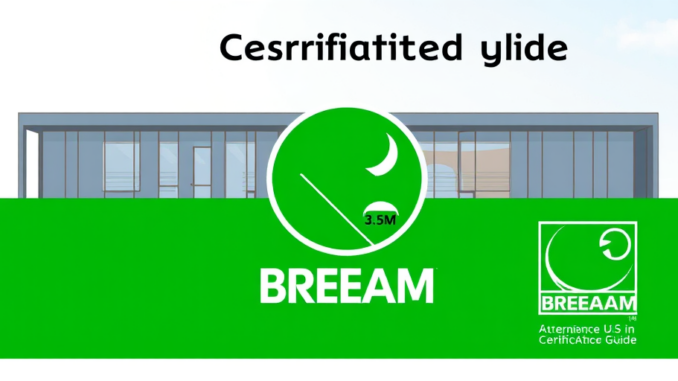
Summary
This article provides a comprehensive guide to achieving BREEAM certification, covering crucial steps from initial planning to final assessment. It emphasizes the importance of early assessor engagement, design integration, and ongoing collaboration for a successful outcome. By following these actionable steps, projects can achieve significant sustainability improvements and contribute to a greener built environment.
Discover how Focus360 Energy can help with BREEAM certification.
Main Story
Achieving BREEAM certification, it’s a real badge of honor, showing that you’re serious about building sustainably and being environmentally responsible. This isn’t just some box-ticking exercise; it’s a commitment. Let’s break down how you can make this happen, step-by-step, and set your project up for success.
First things first: Early Engagement is Key. Seriously, you’ve got to bring in a licensed BREEAM assessor early, like, right at the start, during those initial planning sessions. Their expertise? It’s invaluable. They’ll be able to interpret the BREEAM requirements, do pre-assessments, guide your team – all that jazz. And, frankly, getting them involved early means you’re baking in sustainability from the get-go, making the process much smoother.
Next up: Define Clear Goals and Objectives. You need those SMART goals – specific, measurable, achievable, relevant, and time-bound. Think about what you want to achieve in each BREEAM category relevant to your project. For example, you might aim for a 15% reduction in energy use or target a gold standard for water efficiency. Having these clear objectives? That’s going to keep everyone on the same page and working toward common targets.
Integrate BREEAM into Design, don’t treat it like an afterthought. Weave those requirements into the very fabric of your design process. It’s all about proactive measures. This approach maximizes the value of sustainable outcomes and, importantly, avoids costly retrofits later down the line. For instance, consider how the building is oriented on the site, what materials you’re using, and how efficient your energy systems will be. I remember, once working on a project where sustainability was an afterthought, it was a nightmare to try to back fit things, a major pain. It’s just easier to do things right the first time!
Prioritize Energy Efficiency. It’s a cornerstone of BREEAM, and frankly, it’s just good practice. Think high-performance HVAC systems, optimal insulation, and even renewable energy, solar panels, or geothermal for example. It’s not just for a higher BREEAM rating, it’s about reduced operational costs and lower environmental impact. Everyone wins, right?
And then you have to Champion Water Conservation. You should develop a comprehensive water conservation strategy. That includes water-efficient fixtures, rainwater harvesting and, landscaping that doesn’t guzzle water. Think drought-tolerant plants and efficient irrigation systems. These are clear signs of responsible management.
Embrace Sustainable Materials and Construction. Go for sustainable materials with low environmental impact. Consider the whole lifecycle of the stuff: embodied carbon, sourcing, recyclability, all that jazz. And use construction methods that minimize waste and boost efficiency. Things like modular construction, where things are pre-built in factories, can really speed things up and reduce waste on site.
Now don’t forget to Optimize User Experience. Make sure the building is user-friendly and boosts the well-being of everyone using it. Things like good natural lighting, clean indoor air, and the right temperature, matter. Adaptable and accessible spaces for everyone will contribute to BREEAM credits, sure, but they also create a more pleasant and productive environment.
Innovate and Excel. Don’t be afraid to try some fresh ideas that go beyond just the basics. Could you use a new kind of material that no one else is using? Or a new kind of building method? I have found that doing this adds a real flair to a project and helps boost those scores.
And this is so so important, Document Everything. I can’t stress that enough. Detailed documentation is absolutely essential for demonstrating that you’ve complied with the BREEAM criteria, especially when it comes to the final assessment.
Finally: Ongoing Collaboration and Monitoring. Keep everyone talking: BREEAM assessors, architects, engineers, contractors, and, of course, the building operators. Regular updates make sure everyone’s on the same page. Even after you have certification, keep monitoring the building and look for improvements, that will maintain your standards.
By following these steps, you’ll not only ace the BREEAM certification process but create a building that is genuinely sustainable. It’s more than just a checklist; it’s about making our built environment better for people and the planet. What could be better than that?


So, it’s like sustainable building bingo? “Oh, you got renewable energy! I’ve got low-flush toilets. BREEAM-O!”
Haha, that’s a fun way to think about it! It’s true, there are several key elements, like renewable energy and water conservation, that contribute to the overall BREEAM score. Thinking of it like bingo might actually make it more engaging for project teams, highlighting the different sustainable initiatives we are working towards.
Editor: FocusNews.Uk
Thank you to our Sponsor Focus 360 Energy – https://focus360energy.co.uk
So, if we document *everything*, does that include the biscuit consumption at those collaboration meetings? Asking for a friend… who is also a documented biscuit enthusiast.
That’s a brilliant point! Detailed documentation is vital, and it raises an interesting question. Perhaps tracking biscuit consumption could be a fun, informal way to gauge team engagement and morale during collaboration meetings. I wonder if there would be a correlation with project success!
Editor: FocusNews.Uk
Thank you to our Sponsor Focus 360 Energy – https://focus360energy.co.uk
So, if we’re documenting *everything*, do we need to record the exact hue of paint for optimal well-being credits? Does it need a Pantone reference? Asking for a very particular, slightly obsessive friend…
That’s a fantastic question! While BREEAM doesn’t require specific Pantone references for paint hues, it does consider the impact of materials on indoor environmental quality and well-being. Perhaps considering the light reflectance value (LRV) of colours could be a key point to document and optimise for well-being and energy efficiency.
Editor: FocusNews.Uk
Thank you to our Sponsor Focus 360 Energy – https://focus360energy.co.uk
Document *everything*, you say? Does that include the amount of tea consumed during those intense sustainability discussions? Asking for, erm, myself.
That’s a brilliant point! Perhaps tracking the team’s beverage choices could be a useful indicator of their energy levels throughout those detailed sustainability discussions. It might be another interesting data point when analyzing team dynamics and engagement levels. Great thinking!
Editor: FocusNews.Uk
Thank you to our Sponsor Focus 360 Energy – https://focus360energy.co.uk
The article highlights the importance of user experience, could you expand on how specific design choices for accessibility impact BREEAM scoring beyond just basic compliance?
That’s a great question! Beyond just meeting minimum accessibility standards, incorporating universal design principles can really enhance BREEAM scores. For example, specifying adaptable spaces that cater to a range of needs and abilities, can positively impact the ‘Health and Wellbeing’ category, going above basic compliance.
Editor: FocusNews.Uk
Thank you to our Sponsor Focus 360 Energy – https://focus360energy.co.uk
The emphasis on user experience is vital; exploring how specific material choices impact air quality and thermal comfort could further enhance building performance and well-being.
That’s a really important point! Considering the impact of material choices on air quality and thermal comfort is often overlooked, but it’s crucial for occupant well-being and overall building performance. We could explore how innovative materials can contribute to a healthier indoor environment and boost BREEAM scores.
Editor: FocusNews.Uk
Thank you to our Sponsor Focus 360 Energy – https://focus360energy.co.uk
Document *everything*, you say? Does that include a detailed graph of the project team’s caffeine intake over the certification period? Might reveal some interesting insights…
That’s a very interesting idea! Tracking caffeine could indeed offer some insights into team dynamics and perhaps even be an indicator of stress levels during the process. It raises a good point about alternative metrics we could use to support BREEAM goals.
Editor: FocusNews.Uk
Thank you to our Sponsor Focus 360 Energy – https://focus360energy.co.uk
So, “document *everything*”, eh? Does that include a meticulously detailed log of the project team’s collective sighs of despair as deadlines approach? Just curious.
That’s a very funny point, and it certainly highlights the importance of accurately capturing the project’s emotional landscape alongside the technical specifications. Perhaps a qualitative log of team sentiment could actually be an interesting metric to track, providing insights into team dynamics during BREEAM projects.
Editor: FocusNews.Uk
Thank you to our Sponsor Focus 360 Energy – https://focus360energy.co.uk
“Early engagement is key,” you say? So, like, before the design team even figures out where the coffee machine goes? Seems ambitious.
That’s a funny way of putting it! It does highlight the need to consider practicalities alongside the sustainable goals. Perhaps ensuring the coffee machine is in an easily accessible location could be part of the overall workplace well-being assessment?
Editor: FocusNews.Uk
Thank you to our Sponsor Focus 360 Energy – https://focus360energy.co.uk
So, “Integrate BREEAM into design, don’t treat it like an afterthought” – I guess that means the sustainability team gets a say before the ‘break room’ is designed? Perhaps they should be in charge of the biscuit jar too…
That’s a great point! It highlights how BREEAM principles can extend to even the smallest design elements. Perhaps considering the sourcing and sustainability of the biscuit jar itself could be an interesting project to think about?
Editor: FocusNews.Uk
Thank you to our Sponsor Focus 360 Energy – https://focus360energy.co.uk